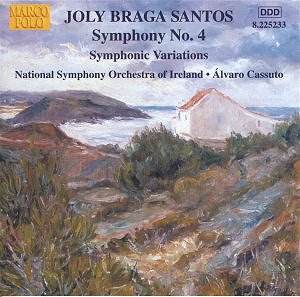Could the Symphonic Variations have been written
without intimate knowledge of Debussy's La Mer and of Ravel's
Daphnis. I doubt it. However such overwhelming impressions did
not obliterate Braga Santos's individuality. Rather they helped bear
it up and were a vehicle for the folk inspiration that lights his most
instantly communicative works. The Symphonic Variations will
not disappoint you if you already adore Moeran, Kodály, Hanson,
Vaughan Williams, Sibelius or Delius. This music rises from mists to
sunrise splendour to a vigorous wildly stomping hammered rhythmic statement
of considerable duration. There is then a cinematographically delicious
fade into a mellifluously chuckling haze (9.52). Only in the bombast
of the closing pages with their echoes of Delius's Appalachia
and Sibelius's Second Symphony do things momentarily lose their creative
grip.
The Alentejo folk heritage can often be heard in these
two works which share the same year of composition. They are also, in
this respect, influenced by the only slightly less compelling symphonies
of Luis de Freitas Branco (1890-1955) which have been recorded by Portugalsom
and reviewed here. It is worth reminding ourselves that the first four
Braga Santos symphonies date from the ages of 22 and 25. All are instantly
accessible without being spineless or lacking character. They are simply
glorious symphonies that must be heard. Let me assure you that once
you get Braga Santos's themes in your head they cannot be shaken off.
The Fourth Symphony has all the virtues of the
Symphonic Variations but an epic span as well. Brucknerian parallels
must be expected but you also have Mahlerian-Delian encounters as in
the opening of the Andante. In the rather Vaughan Williamsy third
movement at 3.33 comes one of those magically flowing golden melodies
that only Braga Santos can call down from an untroubled blue sky. Russian
celebratory festivity marks the finale in echo of the fourth movement
of Rachmaninov's First Symphony (9.22 and 10.04 tr5). I suppose there
is a tendency for Braga Santos to produce a great idea and bring it
round again and again but those ideas are very well held together and
presented. Listen to those punched out horn grunts at 6.23 launching
another fine broad melody at 6.53 and all the time recalling Vaughan
WiIliams' Fifth and the Moeran G minor. The trumpets of the Irish orchestra
make a far less fallible job of those pecked and long repeated notes
than Silva Pereira's Portuguese players on Portugalsom. Cassuto lacks
the choir that should appear in the last five minutes. We therefore
miss the lump-in-the-throat hymn to youth and the hope-filled shining
skies of tomorrow. Nevertheless Cassuto makes a wonderful job of the
peroration. Very convincing - blazing with optimism; buoyant with joy.
We need more music like this.
With the Fifth and Sixth Symphonies Braga Santos's
language took a radically different course invoking Second Viennese
paradigms.
This music is delivered with smashing conviction by
the RTE orchestra. Interesting that Cassuto and Marco Polo have switched
orchestras from the earlier instalments. The sound quality is a great
improvement on the Portugalsom recording
of the Fourth Symphony (Silva Pereira conducting). The performance
is just as spirited, lively and raspingly aggressive.
Braga Santos - a nationalistic impressionist with Iberian
exoticism tempered with the crash of the Atlantic combers and oceanic
blue, green and aquamarine.
Rob Barnett


